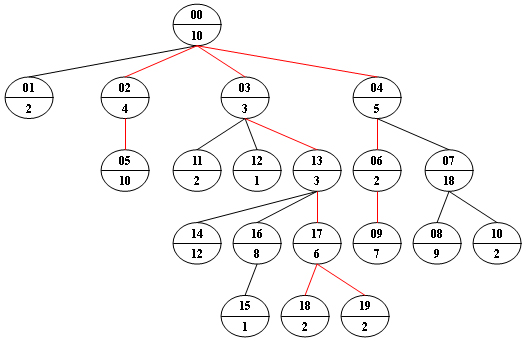Given a non-empty tree with root R, and with weight Wi assigned to each tree node Ti. The weight of a path from R to L is defined to be the sum of the weights of all the nodes along the path from R to any leaf node L.
Now given any weighted tree, you are supposed to find all the paths with their weights equal to a given number. For example, let's consider the tree showed in the following figure: for each node, the upper number is the node ID which is a two-digit number, and the lower number is the weight of that node. Suppose that the given number is 24, then there exists 4 different paths which have the same given weight: {10 5 2 7}, {10 4 10}, {10 3 3 6 2} and {10 3 3 6 2}, which correspond to the red edges in the figure.
Input Specification:
Each input file contains one test case. Each case starts with a line containing 0, the number of nodes in a tree, M (<), the number of non-leaf nodes, and 0, the given weight number. The next line contains N positive numbers where Wi (<) corresponds to the tree node Ti. Then M lines follow, each in the format:
ID K ID[1] ID[2] ... ID[K]where ID is a two-digit number representing a given non-leaf node, K is the number of its children, followed by a sequence of two-digit ID's of its children. For the sake of simplicity, let us fix the root ID to be 00.
Output Specification:
For each test case, print all the paths with weight S in non-increasing order. Each path occupies a line with printed weights from the root to the leaf in order. All the numbers must be separated by a space with no extra space at the end of the line.
Note: sequence { is said to be greater than sequence { if there exists 1 such that Ai=Bi for ,, and Ak+1>Bk+1.
Sample Input:
20 9 24
10 2 4 3 5 10 2 18 9 7 2 2 1 3 12 1 8 6 2 2
00 4 01 02 03 04
02 1 05
04 2 06 07
03 3 11 12 13
06 1 09
07 2 08 10
16 1 15
13 3 14 16 17
17 2 18 19Sample Output:
10 5 2 7 10 4 10 10 3 3 6 2 10 3 3 6 2
AC代码:
#include<bits/stdc++.h> using namespace std; const int maxn=1010; #define inf 0x3fffffff struct node{ int w; vector<int> child; }; vector<node> v; vector<int> path; int n,m,t; bool cmp(int a,int b){ return v[a].w>v[b].w; } void dfs(int index,int nodeNum,int sum){ if(sum>t){ return; } if(sum==t){ if(v[index].child.size()!=0){ return; } for(int i=0;i<nodeNum;i++){ if(i<nodeNum-1){ printf("%d ",v[path[i]].w); } else{ printf("%d ",v[path[i]].w); } } return ; } for(int i=0;i<v[index].child.size();i++){ int nod=v[index].child[i]; path[nodeNum]=nod; dfs(nod,nodeNum+1,sum+v[nod].w); } } int main(){ scanf("%d %d %d",&n,&m,&t); v.resize(n); path.resize(n); for(int i=0;i<n;i++){ scanf("%d",&v[i].w); } int id,k; for(int i=0;i<m;i++){ scanf("%d %d",&id,&k); v[id].child.resize(k); for(int j=0;j<k;j++){ scanf("%d",&v[id].child[j]); } sort(v[id].child.begin(),v[id].child.end(),cmp); } dfs(0,1,v[0].w); return 0; }
